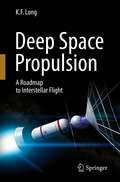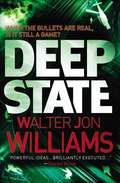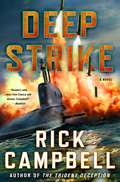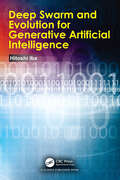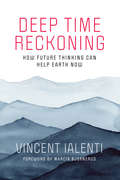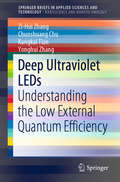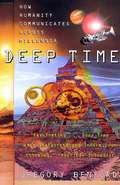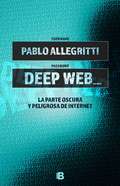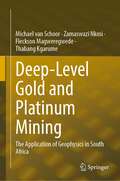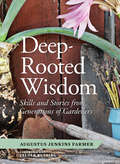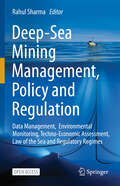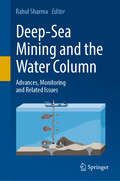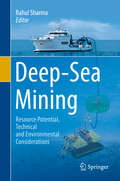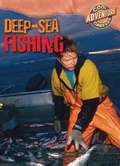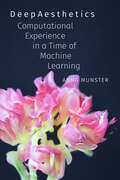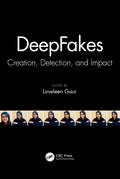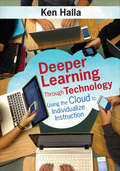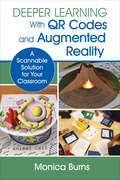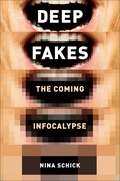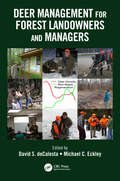- Table View
- List View
Deep Space Propulsion
by K. F. LongThe technology of the next few decades could possibly allow us to explore with robotic probes the closest stars outside our Solar System, and maybe even observe some of the recently discovered planets circling these stars. This book looks at the reasons for exploring our stellar neighbors and at the technologies we are developing to build space probes that can traverse the enormous distances between the stars. In order to reach the nearest stars, we must first develop a propulsion technology that would take our robotic probes there in a reasonable time. Such propulsion technology has radically different requirements from conventional chemical rockets, because of the enormous distances that must be crossed. Surprisingly, many propulsion schemes for interstellar travel have been suggested and await only practical engineering solutions and the political will to make them a reality. This is a result of the tremendous advances in astrophysics that have been made in recent decades and the perseverance and imagination of tenacious theoretical physicists. This book explores these different propulsion schemes - all based on current physics - and the challenges they present to physicists, engineers, and space exploration entrepreneurs. This book will be helpful to anyone who really wants to understand the principles behind and likely future course of interstellar travel and who wants to recognizes the distinctions between pure fantasy (such as Star Trek's 'warp drive') and methods that are grounded in real physics and offer practical technological solutions for exploring the stars in the decades to come.
Deep State
by Walter Jon WilliamsBy day Dagmar Shaw orchestrates vast games with millions of players spanning continents. By night, she tries to forget the sound of a city collapsing in flames around her. She tries to forget the faces of her friends as they died in front of her. She tries to forget the blood on her own hands. But then an old friend approaches Dagmar with a project. The project he pitches is so insane and so ambitious, she can't possibly say no. But this new venture will lead her from the world of alternate-reality gaming to one even more complex. A world in which the players are soldiers and spies and the name of the game is survival.
Deep Strike: A Novel (Trident Deception Series #6)
by Rick CampbellIn Rick Campbell's next action-packed thriller Deep Strike, the U.S. Atlantic fleet is in a race to stop a rogue Russian submarine—funded by ISIS—en route to launch a missile attack against the east coast of the U.S.A shoulder-launched missile attack on a convoy of vehicles leaving the U.N. headquarters in New York kills several diplomats, including the American ambassador. Security footage reveals that the killer behind the attack is a disgraced former special forces operative, Mark Alperi. But before U.S. intelligence operatives can catch up with him, Alperi is already onto the next phase of his plan.With funding from the nearly shattered ISIS, Alperi plans an attack on the U.S. that will be more devastating than 9/11. He bribes a desperate Russian submarine commander with access to an expensive experimental drug for his daughter who is suffering from a rare disease. In exchange, the Russian commander will take his submarine to the Atlantic Ocean and launch a salvo of missiles at various targets along the East Coast of the United States. The commander lies to his crew that it's a secret mission, with dummy missiles, for a training exercise. At the same time, unbeknownst to the commander, Alperi has arranged for four of the missile warheads to be replaced with four surplus nuclear warheads and arms them. When the Russian submarine sinks the U.S. sub that is tracking it, the U.S. military is alarmed. When Intelligence uncovers Alperi's plot, though, it becomes a race against time—find the Russian sub and sink it before it can launch a devastating nuclear attack.
Deep Swarm and Evolution for Generative Artificial Intelligence
by Hitoshi IbaThis book provides theoretical and practical knowledge about swarm and evolutionary approach of generative AI and Large Language Models (LLMs). The development of such tools contributes to better optimizing methodologies with the integration of several machinelearning and deep learning techniques. In particular, it discusses how the “emergence” concept can contribute to the improvement of AI.The book aims to model human cognitive f unction in terms of “emergence” and to explain the feasibility of AI. To this end, it focuses on human perceptions of “utility.” It describes the emergence of various cognitive errors, and irrational behaviours in the multiobjective situations. It also reviews the cognitive differences and similarities between humans and LLMs. Such studies are important when applying LLMs to real-world tasks that involve human cognition, e.g., financial engineering and market issues.The book describes the intelligent behaviour of living organisms. This is to clarify how to achieve AI in the direction of artificial life. It describes sexual selection, which is a well-known natural phenomenon that troubled Darwin, i.e., why evolutionarily useless items evolved such as peacock feathers and moose antlers etc. The book shows how sexual selection is extended as “novelty search” for the application of generative AI, i.e., the image generation with diffusion model. Real-world applications are emphasised. Empirical examples from real-world data show how the concept of deep swarm and evolution is successfully applied when addressing tasks from such recent fields as robotics, e-commerce Web Shop and image generation etc.
Deep Time Reckoning: How Future Thinking Can Help Earth Now (One Planet)
by Vincent IalentiA guide to long-term thinking: how to envision the far future of Earth.We live on a planet careening toward environmental collapse that will be largely brought about by our own actions. And yet we struggle to grasp the scale of the crisis, barely able to imagine the effects of climate change just ten years from now, let alone the multi-millennial timescales of Earth's past and future life span. In this book, Vincent Ialenti offers a guide for envisioning the planet's far future--to become, as he terms it, more skilled deep time reckoners. The challenge, he says, is to learn to inhabit a longer now.
Deep Ultraviolet LEDs: Understanding the Low External Quantum Efficiency (SpringerBriefs in Applied Sciences and Technology)
by Zi-Hui Zhang Chunshuang Chu Kangkai Tian Yonghui ZhangThis book highlights the origin of low external quantum efficiency for deep ultraviolet light-emitting diodes (DUV LEDs). In addition, it puts forward solutions for increasing the internal quantum efficiency and the light extraction efficiency of DUV LEDs. The book chiefly concentrates on approaches that can be used to improve the crystalline quality, increase carrier injection, reduce the polarization-induced electric field within multiple quantum wells, suppress the TM polarization emission, and enhance the light escape from the semiconductor layer. It also demonstrates insightful device physics for DUV LEDs, which will greatly benefit the optoelectronic community.
Deep time: How Humanity Communicates Across Millennia
by Gregory BenfordHumanity's attempts to communicate with itself across ages and to communicate with other spieces across space
Deep web: La parte oscura y peligrosa de internet
by Pablo AllegrittiHace tiempo que el mundo digital llegó para quedarse y ser parte esencial de nuestras vidas, siendo Internet, la red de redes, el lugar desde donde se controlarán, hacia el futuro, casi todas nuestras acciones materiales. <P><P> Para una enorme mayoría de los seres humanos, Internet es solo aquel sector en el que navegan diariamente. Muchos no saben que esa parte es solo la punta de un iceberg comunicacional en el cual su mole sumergida multiplica muchas veces la red de acceso natural. Este sector es el llamado Deep Web (Internet Profunda) que contiene a su vez a la DarkNet (la Red Oscura), organizada en varios círculos, cada vez más profundos y con mayor dificultad de acceso, y donde solo se puede navegar con motores especiales de búsqueda. En ella se libran luchas planetarias de todo tipo entre imperios, terroristas y rebeldes, comercios ilegales, sórdidos vídeos y se replican amenazas constantes hacia la seguridad y el bienestar de la gente. <P> Entender esta parte de la existencia que se ha instalado entre nosotros es de capital importancia para proteger nuestras vidas. Nadie puede quedar al margen de estos conocimientos. La amenaza de Internet Profunda está entre nosotros y nos involucra a todos. Solo conociéndola en sus más recónditos espacios nos podrá prevenir, única manera de salvarnos de los peligros que encierra. Si usted quiere iniciar un viaje a las profundidades de la red, Deep Web es un libro imprescindible
Deep-Buried Large Hydrocarbon Fields Onshore China: Formation and Distribution
by Suyun Hu Tongshan WangThis book analyzes the formation and evolution of the giant hydrocarbon reservoirs based on major basins onshore China. It discusses exploration and research advantages of major basins in China, such as Sichuan, Tarim, and Ordos Basins and also systematically analyzes and summarizes the formation conditions, distribution rules, and main controlling factors of deep oil and gas fields. On this basis, it forecasts the exploration prospect of China's onshore deep oil and gas, providing theoretical guidance and technical support for deep oil and gas exploration breakthrough and large-scale reserves growth. This book focuses on the analysis and discussion of hydrocarbon generation mechanism of deep-paleo source rocks, discusses the accumulation rules of cross-structural reservoir formation and oil-gas enrichment in ancient strata, the combination of gypsum-salt rocks and carbonate rocks, the potential of oil and gas accumulation under salt, the main controlling factors and distribution rules of deep oil and gas fields, and preliminarily grasps the geological understanding of the formation and distribution of deep-large oil and gas fields, namely ①abundant hydrocarbon supplied by two types of source kitchens, ②three large-scale lithologic reservoir rocks, ③hydrocarbon accumulation controlled by three paleoes (paleouplift, paleoplatform margin, and paleofaults), and ④reservoir formation across major tectonic periods. The book serves as a guidance for both researchers and students majoring in petroleum geology and other related fields.
Deep-Level Gold and Platinum Mining: The Application of Geophysics in South Africa
by Michael van Schoor Zamaswazi Nkosi Fleckson Magweregwede Thabang KgarumeThis book provides the basic know-how and guidance to effectively exploit non-destructive geophysical technologies and apply them in the underground mining environment to optimise mineral extraction and to contribute to safer mining. The effective application of these technologies can enable a better understanding of the unseen orebody and the surrounding rock mass ahead of the mining face; the potential benefits of applying in-mine geophysics is demonstrated through a selection of case studies conducted in deep-level hard rock mines in South Africa. This book also offers valuable insight and training material for students in a variety of relevant mining disciplines like geology, rock engineering, mining engineering, mine planning and mineral resource management.
Deep-Rooted Wisdom: Skills and Stories from Generations of Gardeners
by Augustus Jenkins FarmerWe have begun to lose some of the most important skills used by everyday gardeners to create beautiful, productive gardens. With a personality-driven, engaging narrative, Deep Rooted Wisdom teaches accessible, commonsense skills to a new generation of gardeners. Soulful gardener, Augustus Jenkins Farmer, profiles experienced and up-and-coming gardeners who use these skills in their own gardens. Enjoy this chance to get planting, propagation, and fertilizing knowledge handed down directly from the experts in the field.
Deep-Sea Mining Management, Policy and Regulation: Data Management, Environmental Monitoring, Techno-Economic Assessment, Law of the Sea and Regulatory Regimes
by Rahul SharmaDeep-sea mining is currently in a critical phase wherein, detailed resource estimation has led to identification of potentially rich areas on the seafloor that can be mined, as well as testing of pre-prototype seabed mining machines and establishment of pilot plants for processing of deep-sea minerals is underway. This coupled with rigorous environmental data collection along with impact assessment of simulated as well as test mining is not only providing requisite information for likely impacts for development of predictive models but also for developing mitigation measures to minimise such impacts. Interest in mining the seafloor deposits as potential source of critical metals has been enhanced in the current century owing to the rising population and consumer demands, as well as the fact that these minerals contain battery metals such as Co, Ni, Mn besides copper that can help transition to green energy alternatives. However, concerns over ecological impacts on marine ecosystems and those related to economic, social and cultural implications need to be addressed for ensuring sustainable mining of seabed mineral resources. With this in view, this fifth book in the series of &‘Deep-sea Mining&’, focusses on issues related to management, policy and regulation. The book is divided into the following five sections: I – General issues on resource potential and future prospects II – Resource and environmental data management <span lang="EN-GB" style="font-size: 12.0pt; line-height: 115%; mso-ascii-font-family: Calibri; mso-fareast-font-family: 'Times New Roman'; mso-hansi-font-family: Calibri; mso-bidi-font-family: Calibri; mso-ansi-language: EN-GB; mso-bidi-font-weight: bold
Deep-Sea Mining and the Water Column: Advances, Monitoring and Related Issues
by Rahul SharmaThis book focuses on general issues of deep-sea mining for seafloor mineral deposits, as well as the scientific, technical, legal and policy issues related to impacts on the water column. The topic is a growing area of significance due to the ongoing conversations on this issue in the world community, in view of the large-scale consequences resulting from operations of different components of deep-sea mining systems. The chapters are divided in five sections, and are contributed by highly acclaimed scientists, technologists, lawyers and administrators who have decades of experience working on these topics. The information compiled in the book is expected to serve as an important reference for all stakeholders including researchers, contractors, mining companies, regulators and NGOs involved in deep-sea mining and marine environmental conservation. Section 1 provides an overall view of the current status of deep-sea mining and issues related to the water column. Section 2 looks at the engineering considerations for technology related to mining, handling of bulk solids in the marine environment, transporting the ores from seabed to shore as well as processing of deep-sea minerals. Section 3 discusses various approaches for assessment of impacts of deep-sea mining on the water column. Section 4 assesses the chemical, physical and biological characteristics of the water column in different oceans of the world. Finally, section 5 deals with legal, policy and economic aspects of deep-sea mining.
Deep-Sea Mining: Resource Potential, Technical and Environmental Considerations
by Rahul SharmaThis comprehensive book contains contributions from specialists who provide a complete status update along with outstanding issues encompassing different topics related to deep-sea mining. Interest in exploration and exploitation of deep-sea minerals is seeing a revival due to diminishing grades and increasing costs of processing of terrestrial minerals as well as availability of several strategic metals in seabed mineral resources; it therefore becomes imperative to take stock of various issues related to deep-sea mining. The authors are experienced scientists and engineers from around the globe developing advanced technologies for mining and metallurgical extraction as well as performing deep sea exploration for several decades. They invite readers to learn about the resource potential of different deep-sea minerals, design considerations and development of mining systems, and the potential environmental impacts of mining in international waters.
Deep-sea Fishing (Cool Adventure Careers)
by William David ThomasThe first group of titles in an ongoing series introduces students to six amazing adventure careers. Geared for reluctant readers in upper elementary school and above, each high-interest title combines easy-to-follow text with engaging on-the-job photos to spark students' interest in reading and career exploration. Each book is filled with descriptive information about the career, along with the skills and requirements needed to pursue a job in the profiled field.
DeepAesthetics: Computational Experience in a Time of Machine Learning (Thought in the Act)
by Anna MunsterComputation has now been reconfigured by machine learning: those technical processes and operations that yoke together statistics and computer science to create artificial intelligence (AI) by furnishing vast datasets to learn tasks and predict outcomes. In DeepAesthetics, Anna Munster examines the range of more-than-human experiences this transformation has engendered and considers how those experiences can be qualitative as well as quantitative. Drawing on process philosophy, Munster approaches computational experience through its relations and operations. She combines deep learning—the subfield of machine learning that uses neural network architectures—and aesthetics to offer a way to understand the insensible and frequently imperceptible forms of nonlinear and continuously modulating statistical function. Attending to the domains and operations of image production, statistical racialization, AI conversational agents, and critical AI art, Munster analyzes how machine learning is operationally entangled with racialized, neurotypical, and cognitivist modes of producing knowledge and experience. She approaches machine learning as events through which a different sensibility registers, one in which AI is populated by oddness, disjunctions, and surprises, and where artful engagement with machine learning fosters indeterminate futures.
DeepFakes: Creation, Detection, and Impact
by Loveleen GaurDeepfakes is a synthetic media that leverage powerful Artificial Intelligence (AI) and machine learning (ML) techniques to generate fake visual and audio content that are extremely realistic, thus making it very hard for a human to distinguish from the original ones. Apart from technological introduction to the Deepfakes concept, the book details algorithms to detect Deepfakes, techniques for identifying manipulated content and identifying face swap, generative adversarial neural networks, media forensic techniques, deep learning architectures, forensic analysis of DeepFakes and so forth. Provides a technical introduction to DeepFakes, its benefits, and the potential harms Presents practical approaches of creation and detection of DeepFakes using Deep Learning (DL) Techniques Draws attention towards various challenging issues and societal impact of DeepFakes with their existing solutions Includes research analysis in the domain of DL fakes for assisting the creation and detection of DeepFakes applications Discusses future research directions with emergence of DeepFakes technology This book is aimed at graduate students, researchers and professionals in data science, artificial intelligence, computer vision, and machine learning.
Deeper Learning Through Technology: Using the Cloud to Individualize Instruction
by Kenneth P. HallaUse the Cloud to Individualize Your Instruction and Watch Your Students Thrive! The advent of cloud-stored data that can be entered, changed, and accessed anywhere is a development full of potential for today’s classroom. This book is the all-in-one resource you need to be sure your students reap the fullest rewards from cloud-based developments. Teacher and top ed-blogger Ken Halla explains: Strategies for leveraging the cloud to create a self-paced, learner-centered classroom How to take advantage of tech tools to facilitate learning Real-life case studies and activities to ensure an enjoyable implementation experience. Stay ahead of the curve with Ken Halla’s strategies, which you can implement the next morning. "Halla′s book, written from practitioner experience, provides practical and simple integration techniques that will assist both novice and experienced teachers incorporate technology to enhance student learning." —Eric Sheninger, author of Digital Leadership, Changing Paradigms for Changing Times "This is a must read--a detailed nuts and bolts guide to classroom tools in the cloud." —Michael B. Horn, Co-Founder and Director, Christensen Institute Author of Disrupting Class: How Disruptive Innovation Will Change the Way the World Learns. "Whether you are an ed tech veteran or just getting started, Halla′s book will help you tailor learning to meet the needs of your students. This book will help you create the learner-focused classroom you want to build! A must-have resource for today′s teachers!" —Jaime Casap, Global Education Evangelist Google
Deeper Learning Through Technology: Using the Cloud to Individualize Instruction
by Kenneth P. HallaUse the Cloud to Individualize Your Instruction and Watch Your Students Thrive! The advent of cloud-stored data that can be entered, changed, and accessed anywhere is a development full of potential for today’s classroom. This book is the all-in-one resource you need to be sure your students reap the fullest rewards from cloud-based developments. Teacher and top ed-blogger Ken Halla explains: Strategies for leveraging the cloud to create a self-paced, learner-centered classroom How to take advantage of tech tools to facilitate learning Real-life case studies and activities to ensure an enjoyable implementation experience. Stay ahead of the curve with Ken Halla’s strategies, which you can implement the next morning. "Halla′s book, written from practitioner experience, provides practical and simple integration techniques that will assist both novice and experienced teachers incorporate technology to enhance student learning." —Eric Sheninger, author of Digital Leadership, Changing Paradigms for Changing Times "This is a must read--a detailed nuts and bolts guide to classroom tools in the cloud." —Michael B. Horn, Co-Founder and Director, Christensen Institute Author of Disrupting Class: How Disruptive Innovation Will Change the Way the World Learns. "Whether you are an ed tech veteran or just getting started, Halla′s book will help you tailor learning to meet the needs of your students. This book will help you create the learner-focused classroom you want to build! A must-have resource for today′s teachers!" —Jaime Casap, Global Education Evangelist Google
Deeper Learning With QR Codes and Augmented Reality: A Scannable Solution for Your Classroom (Corwin Teaching Essentials)
by Monica BurnsEngaging, interactive learning—right in your students’ hands! What if your students’ mobile devices became an instructional asset rather than a distraction? Discover how free, scannable technology can enrich learning, while captivating students. Best of all, these technologies are easy to quickly implement within your classroom. Learn about QR codes and Augmented Reality (AR) Reach each student with new, hands-on learning opportunities Embrace the ACES Framework for teaching with scannable technologies: Access, Curate, Engage, and Share Promote self-directed learning and showcase students’ creations Leverage technology to connect classroom activities with students’ families and the broader community
Deeper Learning With QR Codes and Augmented Reality: A Scannable Solution for Your Classroom (Corwin Teaching Essentials)
by Monica BurnsEngaging, interactive learning—right in your students’ hands! What if your students’ mobile devices became an instructional asset rather than a distraction? Discover how free, scannable technology can enrich learning, while captivating students. Best of all, these technologies are easy to quickly implement within your classroom. Learn about QR codes and Augmented Reality (AR) Reach each student with new, hands-on learning opportunities Embrace the ACES Framework for teaching with scannable technologies: Access, Curate, Engage, and Share Promote self-directed learning and showcase students’ creations Leverage technology to connect classroom activities with students’ families and the broader community
Deepfakes: The Coming Infocalypse
by Nina SchickEverything you need to know about "deepfakes" and what could become the biggest information and communications meltdown in world history.In a world of deepfakes, it will soon be impossible to tell what is real and what isn't. As advances in artificial intelligence, video creation, and online trolling continue, deepfakes pose not only a real threat to democracy -- they threaten to take voter manipulation to unprecedented new heights. This crisis of misinformation which we now face has since been dubbed the "Infocalypse."In DEEPFAKES, investigative journalist Nina Schick uses her expertise from working in the field to reveal shocking examples of deepfakery and explain the dangerous political consequences of the Infocalypse, both in terms of national security and what it means for public trust in politics. This all-too-timely book also unveils what this all means for us as individuals, how deepfakes will be used to intimidate and to silence, for revenge and fraud, and just how truly unprepared governments and tech companies are for what's coming.
Deepwater Alchemy: Extractive Mediation and the Taming of the Seafloor
by Lisa Yin HanHow underwater mediation has transformed deep-sea spaces into resource-rich frontiers Green energy technologies such as windmills, solar panels, and electric vehicles may soon depend on material found at the seabed. How did a space once imagined to be empty and unfathomable come to be thought of as a treasure trove of resources? Lisa Yin Han traces how contemporary developments in underwater sensing and imaging materially and imaginatively transmogrify the ocean bottom into a resource frontier capable of sustaining a digitally connected global future. Set against the backdrop of climate change, energy transition, and the expansion of industrial offshore extractions, Deepwater Alchemy looks at oceanic media and its representation of the seabed in terms of valuable resources. From high-tech simulations to laboratories and archives that collect and analyze sediments, Han explores the media technologies that survey, visualize, and condition the possibility for industrial resource extraction, introducing the concept of extractive mediation to describe the conflations between resource prospecting and undersea knowledge production. Moving away from anthropocentric frameworks, she argues that we must equalize access to deep ocean mediation and include the submerged perspectives of multispecies communities. From the proliferation of petroleum seismology to environmental-impact research on seabed mining to the development of internet-enabled seafloor observatories, Deepwater Alchemy shows us that deepwater mediation is entangled in existential hopes and fears for our planetary future. As the ocean bottom becomes increasingly accessible to people, Han prompts us to ask not whether we can tame the seafloor, but, rather, why and for whom are we taming it?
Deepwater Horizon
by James M. Blossom Earl BoebertIn 2010 BP's Deepwater Horizon catastrophe spiraled into the worst human-made economic and ecological disaster in Gulf Coast history. In the most comprehensive account to date, senior systems engineers Earl Boebert and James Blossom show how corporate and engineering decisions, each one individually innocuous, interacted to create the disaster.
Deer Management for Forest Landowners and Managers
by David S. deCalesta and Michael C. EckleyThis book is designed to help landowners and forestry professionals develop, implement, and monitor programs to manage both deer and forests with emphasis on resolving deer impact issues. Chapters cover management strategies through identifying and setting goals; managing deer populations and deer impact on land; economics of forest, deer, and impact management; human dimensions of deer management; and developing and implementing integrated management plans. The book presents an integrated, quantitative approach for managing deer populations and impacts so users can manage forest resources sustainably.
